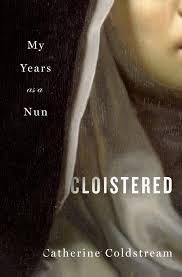Cloistered: My Years as a Nun, by Catherine Coldstream
This memoir is an honest rendering of Coldstream’s experiences as a cloistered Carmelite nun in the 1990s in northern England. The Catholic Church has many orders of nuns, each with its own charism, a special grace given by the Holy Spirit, to be used to serve the Church and the world. This gift may be for teaching, healing, or prayer and sacrifice, for example. A convert to Catholicism, Coldstream’s deepening faith propelled her to live it fully, thus she explored various religious orders to discern which fit her gifts. Upon visiting the Akenside Priory, the enclosed silence of the Carmelite life seemed a perfect fit.
Catherine entered at age 27, after the death of her beloved, elderly father. She was the oldest of three children of her father’s second marriage, to a younger wife whose theater career kept her away from the family. The couple were mainly incompatible, meaning what family life there was came from her father. Catherine, as an accomplished violist, pursued some advanced education, then went to Paris, creating experimental music with a like-minded community. Upon her father’s death, the family fragmented, each going their own way. It was then that Catherine began her spiritual journey, leading her to the Carmelite way.
Coldstream describes her initial visits, her period as a postulant, followed by first vows, becoming a novice, and after a three year period, taking her final vows, becoming a Carmelite nun. She describes the physical environment, the schedule of community prayer, private prayer, and work, and the work she did, as she was able to use her musical gift as choir director and organist. As a young, fit novice, Catherine could handle the needed outside work in the vegetable garden, helping grow the food needed for their vegetarian diet. Walks outside were allowed, and Catherine felt great relief from the cloister by being in nature, enjoying the physical exertion.
It struck Catherine as peculiar that little effort was made to really get to know the postulants’ backgrounds and motivations. They were taught the way, expected to be tough and strong, buck up and get on with it. The point was to find solace in your private relationship with God, not to rely on fellow sisters for emotional support, or intellectual exploration of theological matters. Akenside dispensed with several aspects of the Rule, including weekly chapter meetings, where problems were meant to be discussed and resolved as a community. Elections for Prioresse, the sister who was to be the authority for the community, were held every three years. Akenside violated the Rule by electing the same sister as Prioresse for multiple terms, creating a cult of personality, or an unchallenged or undisputed leader for years at a time. Catherine describes how Mother Elizabeth plays favorites, dispenses treats randomly, developing a core of supporters, effectively splitting the community in two. Coldstream describes how this led to the mental breakdown of younger novices, and escape of sisters to other Carmelite communities. After ten years, it finally led to Catherine’s escape, return, then final proper ending of vows from Rome.
This is a beautiful, insightful book. The author expertly gives you a true feel for this way of life, its fulfillments and despairs, physical, emotional, and spiritual. When following St. Teresa of Avila’s Rule, the sixteenth century reformer of the order, based on the Desert Fathers of Carmel, third century hermits who pursued the life of solitude and prayer, the disciple can find true relationship with God, and fulfillment of the mission of prayer for the world. She documents the problems that arise when a community allows one person to hijack the process. She also questions whether the upcoming generations of women are able to handle the emotional austerity, without sufficient supports. This is a fascinating memoir, exploring one path of radical sacrifice and love for God.

